The story that culminates Nov. 20 and 21 with planting of more than 10,000 early blue violets in the Clatsop Plains began more than a decade ago. It’s one of those multigenerational sagas with a long list of characters, set in a variety of locations. And if we do the job right, it will be a never-ending story: the violets we plant this fall will grow and multiply in the years ahead, helping to make the prairie a more inviting place for the Oregon silverspot butterfly (whose larve eat dried violet stems and leaves—and nothing else).[wc_spacing size=”10px”]
Chapter 1: Mapping Violet Country (Early 2000s)
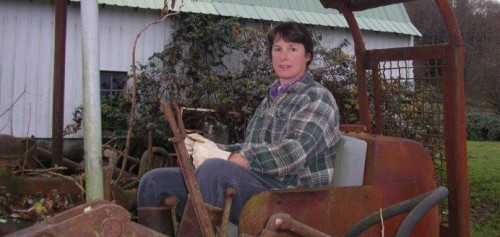
Tammi Lesh, 2004
The U.S. Fish and Wildlife Service first became concerned about the health of the Oregon silverspot butterfly population in the 1970s, when it became clear that this species was becoming scarce in parts of its range, which extends from Del Norte County, California, to southwestern Washington. When Tammi Lesh became the north coast land steward for The Nature Conservancy’s Oregon office in 2001, she joined the USFWS’s Silverspot Butterfly Working Group along with Katie Voelke, then NCLC’s land steward, now its executive director. (Tammi currently serves as vice president of NCLC’s board of directors.)[wc_clear_floats]
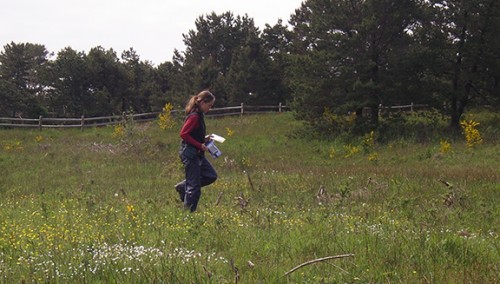
Katie Voelke looking for violets in Pinehurst preserve, 2005
They knew that without plenty of early blue violets, there would be no Oregon silverspots in the coastal prairie of Clatsop County. “We mapped the whole Clatsop Plains for coastal prairie habitat, especially violets,” Tammi recalls. “Every square inch”—including private property, when they could get permission.

Mike Patterson
Seaside biologist Mike Patterson began assisting those efforts, surveying both butterflies and butterfly habitat in the Clatsop Plains and beyond.
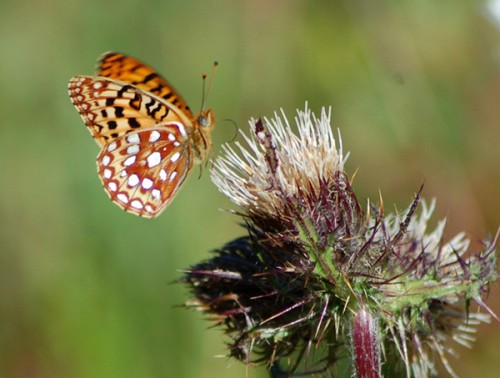
Oregon silverspot butterfly (photo by Mike Patterson)
Mike counts Oregon silverspot butterflies every summer as far south as Rock Creek in coastal Lane County. And he has become the go-to guy for violet surveying on public and private land in the Clatsop Plains. While others relied on estimates, he says, “Basically I would go into an area and try to find every violet and mark it using GPS.”
Chapter 2: Seeds of the Future (2006)
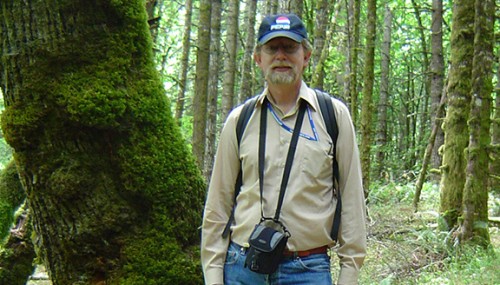
Bill Vagt
In 2006 Bill Vagt, natural resources specialist for the Oregon Military Department, led a violet seed-collecting expedition at Camp Rilea, on the Clatsop Plains. (The Department of Defense has the highest density of species listed as threatened or endangered under the Endangered Species Act of any other federal land management agency.) That first time out they managed to collect about 100 seeds. “Early blue violet seeds are extremely difficult to collect in the wild,” Bill says. “When the seed pods point down, they’re not ripe; if you pick them, they won’t germinate. But when the pods point up, you have about a two-day window before they explode” and the tiny seeds scatter. Every violet plant in the prairie ripens on a slightly different schedule.
Bill continued to collect violet seeds at Camp Rilea through the years. One Friday afternoon, at the end of a collecting trip, he left a paper bag full of just-picked violet seeds open on his desk in Salem, only to find Monday morning that the pods had ripened over the weekend, exploding and scattering the tiny seeds in every corner of the room.[wc_clear_floats]
Chapter 3: We Are Family (2006 to 2014)

Amy Barstow among the violets
Amy Barstow manages seed and plant production at the Natural Resources Conservation Service’s Corvallis Plant Materials Center. She was already growing violets to plant on the central coast when Bill Vagt brought her seeds from the Clatsop Plains in 2006. The violet seeds were first planted in pots and later transplanted to a field covered with a woven plastic weed barrier cut with Xs, where the seedlings were inserted. That way, when the violet seed pods reached maturity, scattering seed on the barrier fabric, Amy could just vacuum them up. “We’re able to produce a lot of seed that way,” she says—”twenty pounds from a 0.1-acre field.” Every year she would plant more violets from the Clatsop Plains seed stock.[wc_clear_floats]
Meanwhile, back at the coast, NCLC hired a stewardship director in 2009. NCLC had just purchased 106-acre Reed Ranch, in the middle of the Clatsop Plains. The stewardship director assumed oversight of annual violet surveys there and at other NCLC properties in the coastal prairie.
Melissa Reich became the new stewardship director in 2013, bringing with her several years of experience with the habitat challenges confronting the silverspot butterfly. While earning her biology degree at Lewis & Clark College, she assisted an ecology professor researching Oregon silverspots. She then spent five years with The Nature Conservancy working to improve butterfly habitat on the Oregon Coast.
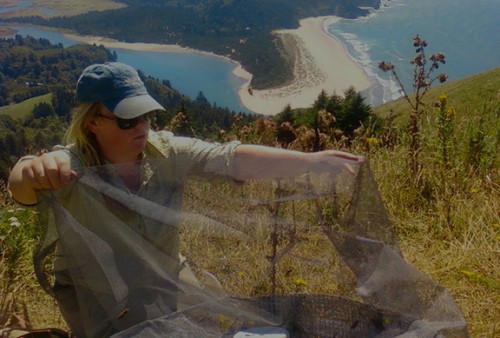
Melissa Reich at Cascade Head, releasing Oregon silverspot butterflies raised at the Oregon Zoo
NCLC’s former stewardship director, meanwhile, had assumed coordination of Northwest Oregon Restoration Partnership, a regional native plant propagation and restoration effort in Tillamook—where the next chapter of the Clatsop Plains violet story would unfold.
Chapter 4: Many Hands (2014)
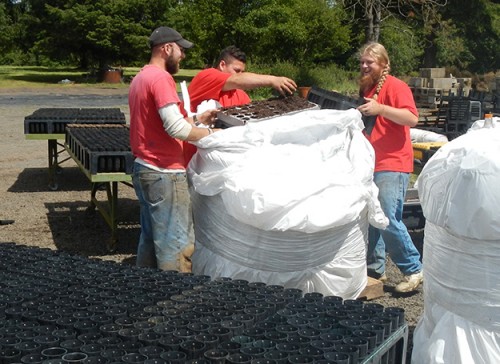
Camp Tillamook work-study nursery
By this time several generations of violets had been grown in Corvallis from the Clatsop Plains seed stock. Early in 2014 a bag of Corvallis-grown violet seeds was delivered to NORP in Tillamook. NORP partners with Camp Tillamook, an Oregon Youth Authority facility providing work-study for youths transitioning out of detention. Young men at the camp filled more than 15,000 plastic plug containers at the nursery at Camp Tillamook.

On the last day of January 2014, the entire NCLC staff and several volunteers travelled to Camp Tillamook to plant violet seeds—11,760 plug containers in all! Three of them returned for more potting a week later and brought the total to 16,000. (Their return to Seaside was delayed a day after snowfall closed US 101 north of Manzanita.)
Chapter 5: Waiting, Weeding and Moving (2015)

NCLC staffers (left to right) Amy Hutmacher, Katie, Melissa, and Lynette Villagomez.
The plan was to plant the violets seedlings a year later, but they weren’t big enough. Instead the staff traveled to Tillamook in March 2015 for a day of violet-weeding.
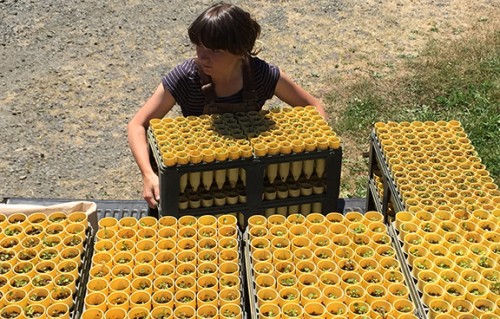
Summer intern Ari Freitag
In June Land Steward Eric Owen and NCLC’s three summer interns transported the violets from Camp Tillamook to NCLC’s Circle Creek property in Seaside. The baby violets in their plug containers filled five pickup trucks. All summer long the interns tended the violets—“Even when it rained, we pretty much had to water them every day,” Eric recalls. After the interns left at the end of summer, Eric was part of a crew that migrated the violets once more to Fort Clatsop, where the National Park Service has a native plant nursery (with an automatic sprinkler system).
Chapter 6: Almost Home
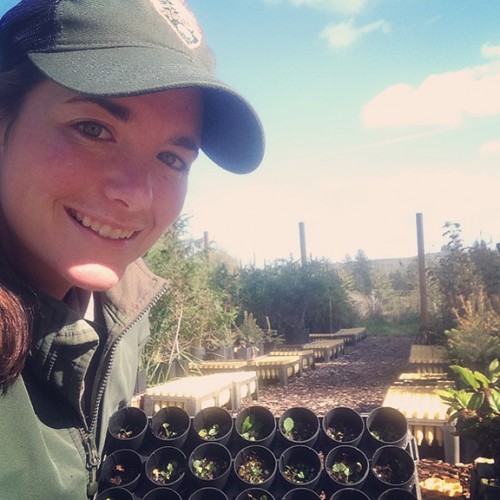
Jenny Bell
“Honestly, they caught my eye yesterday,” said Jenny Bell, NPS biological technician at Fort Clatsop on a sunny day in early October. She and Carla Cole had been caring for the violets as they awaited planting in November. “They were looking really good in their little pots, really healthy,” Jenny said. “They’re being good nursery guests.”
Epilogue: Help us write it!
Join us for the Big Violet Planting Nov. 20 and 21. Come by yourself, or round up a group of friends. E-mail Melissa Reich at melissar@NCLCtrust.org to let her know how many are coming.
Comments